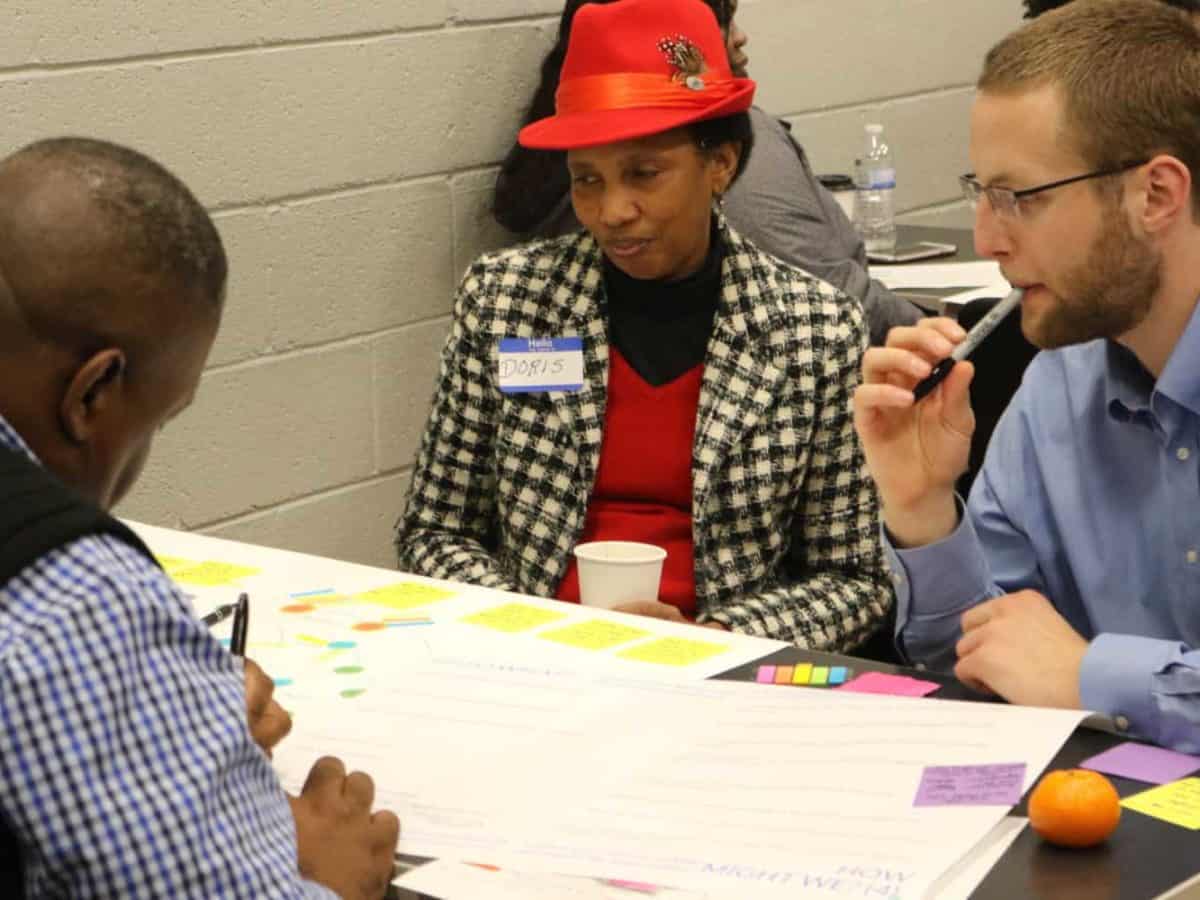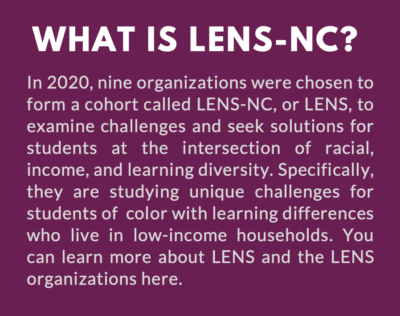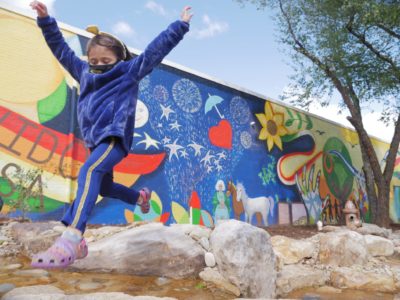

|
|
Andrew Harding is a white man who teaches social studies and coaches football at Tarboro High School, where enrollment is more than 80% Black. He doesn’t reach for the concept of “colorblindness” to connect with his students, though. He reaches for his past — his experience growing up in poverty and suffering trauma.
He finds connection there, where he can honor his students’ unique identities. A big part of that connection, he says, is knowing that there are events in each of his students’ lives that, depending on their response, determine outcomes for them.
Sometimes, their responses aren’t the best. But blindly punishing them for those responses doesn’t make sense to him, he says. He’s had poor responses in his own past, after all, and he has gotten where he is now through healing and learning to do better.
He leads now with trauma-responsive interventions because he wants to give his students and players the same opportunities to heal.
“And we tell our kids this isn’t going away,” he said of the approach. “This is something that we wholeheartedly believe in.”
Harding is invested in becoming better at it, too. He has joined an initiative with Rural Opportunity Institute, an organization based in Edgecombe County that uses human-centered design to help residents build and implement trauma resiliency and healing in the community.
As part of the Learning for Equity: A Network of Solutions (LENS) initiative, ROI is just one group promoting healing and restorative approaches to student behavior. The group says trauma too often goes unidentified in schools, and students end up being punished for things outside their control. That’s particularly true of students of color and students with disabilities.
Trauma in schools
Black and Brown kids, researcher Sal Terrasi says, are especially at risk because historical and systemic racism means they are more likely to live in economic disadvantage or feel threatened because of their skin color.
“What is it that we can do as adults to accommodate that child, and to change the environment to make that child be successful, and to meet his or her needs?” said Terrasi, project director of the Lesley Institute for Trauma Sensitivity. “And we try to do that and see how far we can get with that before we diagnose the child as having a deficit.”
In the late 1990s, the Centers for Disease Control and Prevention and Kaiser Permanente conducted a 10-year longitudinal study of adverse childhood experiences (ACEs), a term that includes abuse, household challenges, and neglect. The ACEs categories, according to the study, are events or experiences that can result in trauma.
The study of 17,000 adults reflecting on their childhood experiences found that more than 60% had at least one adverse childhood experience and 38% had two or more. The study also found a relationship between ACEs and negative health outcomes as adults.
While the research methodology tried to control for demographics, the study group skewed heavily white (75%) and affluent (75% attended at least some college).
“The ACEs categories originally didn’t talk about neglect, didn’t talk about homelessness, didn’t talk about community violence, didn’t talk about things like food insecurity, didn’t talk about chronic poverty, and certainly didn’t talk about things like institutional racism, systemic discrimination or anything like that,” said Terrasi, who presented to the LENS organizations at a convening last October. “We know so much more now than we did about trauma when this study was originally conducted in the late ’90s.”
Roy Wade, a doctor at Children’s Hospital in Philadelphia, co-authored a 2014 study of urban youth that included a more diverse sample and studied many of the things Terrasi mentions. That study found additional categories of adverse childhood experiences, including single-parent homes; exposure to violence, adult themes, and criminal behavior; personal victimization; bullying; economic hardship; and discrimination.
Systemic racism and complex trauma
When the trauma is in response to a series of events, as in the case of Black and Brown kids who live in conditions created by the compounded effects of slavery, Black Codes, and Jim Crow, it results in something called complex or developmental trauma.
“It’s what happens when you’re living in an unfavorable situation and you experience toxic stress, day after day after day,” Terrasi said. “And that can lead to a pernicious, deleterious, and harmful type of trauma, which we see now affecting children in a major way in our schools every day.”
These students often also experience another kind of trauma, historical trauma, because their parents might have grown up in these conditions and the trauma those parents experienced in schools and the community went unaddressed.
“They are still suffering from those effects,” said Jason Marshall, a national education consultant who presented to LENS alongside Terrasi. “So we think about our young people and the families that they go home to every day. What are they still holding in those homes? What have been their parents’ experiences in school? [Do] they still have trauma from their past days in school as marginalized students who don’t have a lot of access to resources?”
Kids can “catch” this trauma from caregivers as if it were contagious, Marshall said. And it can mean students have difficulty with trust and perceive the school environment as threatening.
“We need to work with students to create a sense of community, a sense of belonging, so that students, and I mean all students, feel that they belong, that their presence is valued in the community,” Terrasi said.
Creating community to heal trauma in Edgecombe County
Terrasi says most schools are not trauma-informed spaces, but every school should be. In fact, he says, they should be trauma-sensitive spaces. Trauma-informed means adults in the building are educated on trauma. Trauma-sensitive means they are doing something about it.
“We try to do that by focusing on relationships, the establishment of routines and rituals, creating venues for honest communication with students — to not only listen to the words that students are saying to us but to understand and to be sensitive to the emotions that underlie those words,” he said.
That’s what Harding is doing now at Tarboro High, where he’s the defensive coordinator for the football team. About five years ago, while attending a conference with Tarboro’s head football coach, he began learning how to show up in trauma-sensitive ways for his students and players, he says. From the conference, he extracted lessons about discipline that prioritizes growth and healing over punishment.
Last year, he said, he realized he could build on that experience after meeting ROI co-founder Seth Saeugling, who told him about the group’s work in training resiliency leaders and creating healing environments in schools.
“And I texted our head football coach and said, dude, this is the next steps for everything we’ve been talking about,” Harding said. Now, Harding joins a group of community members, including school leaders and teachers, who are taking the next steps together to put healing ahead of punishment.
When ROI co-founders Saeugling and Vichi Jagannathan began their work in Edgecombe, they focused on human-centered design (HCD). They wanted to help communities help themselves by defining their own problems, discovering their own needs, and working toward their own solutions.
ROI has performed several rounds of HCD interviews in Edgecombe, and “what people largely named were stories of unaddressed trauma and stories of stress,” Saeugling said. “And so we really focused on ACEs and resilience.”
As part of the LENS initiative, ROI focuses on learning, healing, and connecting.
“What can we do to positively impact ourselves and the people around us?” Saeugling said.
Through the LENS work, the community has helped more than 25 school and community leaders to become resilience trainers. Another team under the LENS project started by helping the school system develop a new code of conduct, and is now working with schools to create healing spaces.
Much of the work is aimed at shifting the school climate and default responses from punishment and isolation toward healing and safety. It also involves families in the restorative process.
“We all agreed that good discipline maintains and even strengthens relationships, and doesn’t negatively impact learning,” said Na’im Akbar, who is helping to lead the LENS efforts in Edgecombe. “Our data also tells us that while we want grace and understanding in our everyday lives, we sometimes have a hard time extending that grace … to the parents of the school.”
Posters are going up in school halls to remind students of ways to cope with trauma. Educators are creating safe spaces for students to come when they are having trouble regulating. And a group of students is starting a youth podcast to share experiences with trauma and countermeasures that have helped.
Giving kids safe spaces to learn
The community approach is similar in Wake County, where LENS member Education Justice Alliance is fighting to make schools restorative spaces.
In the Wake County Public School System, the largest district in the state, Black students received 62% of all short-term suspensions in 2018-19, even though they made up less than 23% of the student population.
The data on school-based referrals to the criminal justice system are even more staggering. Black students represented 73% of referrals that school year.
“So much of our work is around really telling the truth as we know it to be,” EJA Executive Director Letha Muhammad said. “And even uncomfortable truth.”
The truth, Muhammad and Marshall say, is that many students of color do not feel safe in the presence of police officers.
“And so we know that our young people currently are living within this world; this is their truth,” Marshall said. “That police is not safe for them, and a lot of times they have police at their schools, so they’re in classrooms that are trauma-induced spaces, or actual sites of oppression.”
EJA has advocated for the removal of school resource officers from Wake County. It wants district schools to use peace builders instead. PeaceBuilders is a program that focuses on discipline prevention and positive response. Participants use de-escalation techniques and are trained to assist with school social emotional learning efforts.
“We can address trauma and make sure that students are in a place where they feel safe and they feel valued,” Muhammad said.
Through LENS, EJA is expanding its advocacy and organizing work. The group is working with Wake County’s board of education to gain access to better data to inform advocacy efforts. Last month, EJA’s efforts resulted in school board approval of collection of more detailed data about students with disabilities and English language learners.
“This is significant because we have always known Black and Brown students are disproportionately referred to the school resource officers,” Muhammad said. “But we suspect that students with disabilities or IEPs are also. So with this new mandate to collect data, this will give us more information and to continue to push to remove school resource officers from all Wake County Public Schools, as well as across North Carolina.”
Muhammad said these aren’t the first steps her group has taken, and they aren’t the last. The goal is to continue naming problems, particularly for students of color with learning differences, so that more people understand that the school experience, itself, is a traumatic experience for many marginalized students.
Marshall says creating this awareness is important, but it must be met by productive action on the other end.
“What we know about the U.S. school system, because we’re in a country that oppresses most marginalized people consistently, is that those same schools are sites of oppression,” Marshall said. “And so you’re either going to maintain that site of oppression, that learning space for a young person and for yourself, or you’re going to choose to start doing practices that are moving everyone toward being in a liberative space. That is a decision that has to be made, make no bones about it.”




